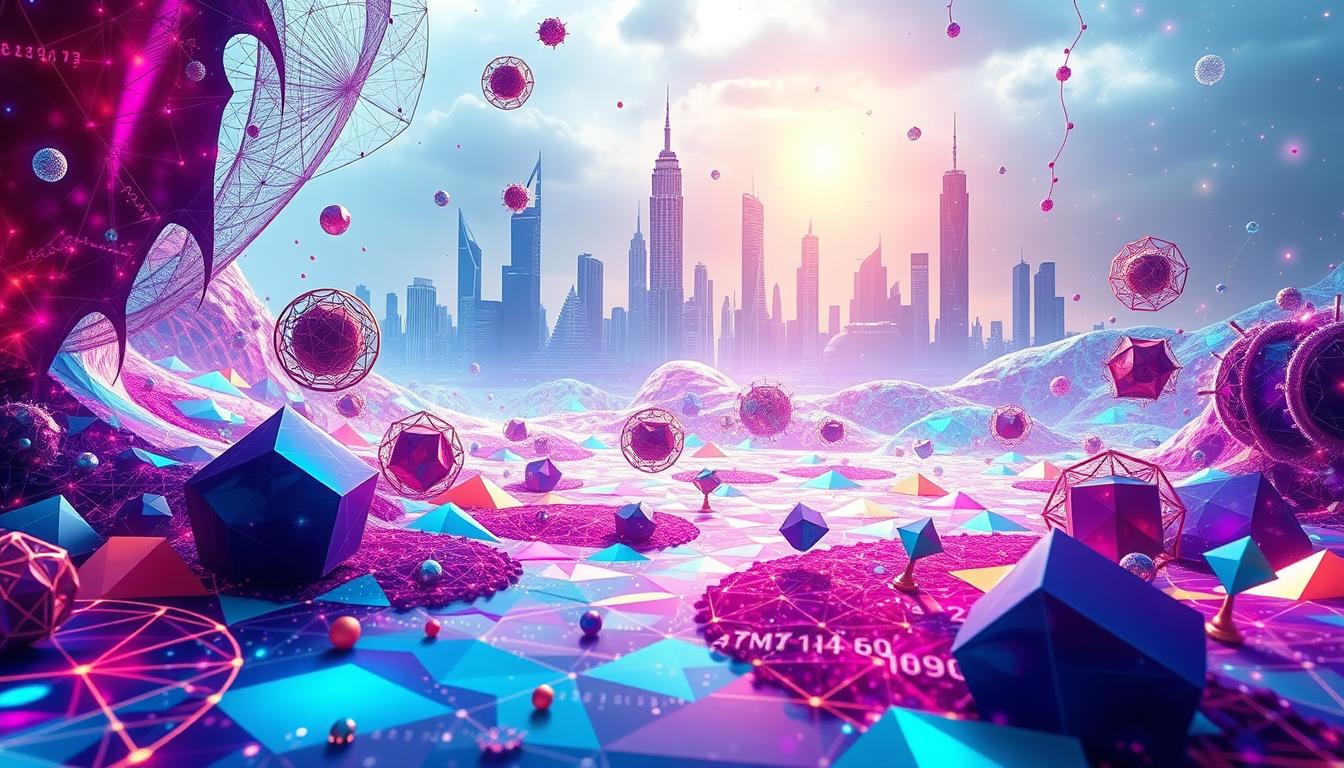Imagine creating stunning digital art that captivates audiences worldwide. Behind the scenes, mathematical concepts play a crucial role in shaping the visual elements that make digital art so compelling.
The connection between math and art is more than just a coincidence. It is a symbiotic relationship where mathematical principles inform the creative process, enabling artists to produce intricate patterns, shapes, and designs that are both aesthetically pleasing and mathematically sound.
Key Takeaways
- Math is a fundamental component of digital art, influencing the creation of visual elements.
- The connection between math and art enables artists to produce intricate and complex designs.
- Understanding mathematical concepts can enhance an artist’s creative process.
- Digital art relies heavily on mathematical algorithms and principles.
- The intersection of math and art leads to innovative and captivating visual experiences.
The Hidden Mathematical Foundation of Digital Art
Behind every pixel and every digital brushstroke lies a complex mathematical framework. This framework is what enables digital artists to create intricate and detailed artworks. The use of mathematical concepts in digital art is not just about creating aesthetically pleasing visuals; it’s about applying precise algorithms and techniques to achieve the desired outcome.
Beyond the Visual: Numbers Behind the Canvas
Digital art is not just about visual appeal; it’s also about the numerical values that underlie every element of the artwork. Mathematical concepts such as geometry and algebra play a crucial role in determining the composition, color palette, and overall aesthetic of a digital piece. By understanding and manipulating these mathematical elements, artists can create complex and nuanced artworks.
The use of algorithms and mathematical models allows digital artists to generate intricate patterns and shapes that would be difficult or impossible to create by hand. This blend of artistry and mathematical precision is what gives digital art its unique character.
The Computational Nature of Digital Creation
The process of creating digital art is inherently computational, relying on complex algorithms and mathematical calculations to produce the final image. Digital artists must have a deep understanding of these computational processes to effectively manipulate and transform their creations. By leveraging mathematical concepts and computational techniques, artists can push the boundaries of what is possible in digital art.
This intersection of mathematics and art is not just about technical proficiency; it’s also about creative vision. Artists who understand the mathematical underpinnings of their craft can unlock new possibilities for expression and innovation.
A Brief History: When Math Met Art
The connection between math and art is not a recent development; it has roots in ancient civilizations. The historical interplay between mathematical principles and artistic expression has been a driving force behind many creative innovations.
From Ancient Patterns to Digital Revolution
Ancient cultures utilized mathematical concepts to create visually stunning and harmonious designs. The use of geometric patterns in Islamic art and the application of the golden ratio in ancient Greek architecture are early examples of this intersection. As civilizations evolved, so did the complexity and sophistication of mathematical art forms.
The advent of digital technology marked a significant turning point in the relationship between math and art. Computers enabled artists to explore new dimensions of creativity, leveraging algorithms and mathematical models to generate intricate patterns and structures that were previously unimaginable.
Pioneers Who Bridged the Gap
The fusion of mathematics and art has been championed by numerous pioneers throughout history. These individuals have played a crucial role in advancing our understanding of how mathematical concepts can be harnessed for artistic purposes.
Early Computer Artists of the 1960s
The 1960s saw the emergence of early computer artists who began experimenting with digital technologies to create art. Pioneers like Frieder Nake and Georg Nees were among the first to use algorithms and computer graphics to produce innovative works that highlighted the potential of math in digital art.
Modern Mathematical Artists
Today, artists continue to push the boundaries of what is possible when math meets art. Contemporary practitioners are using advanced mathematical concepts, such as fractal geometry and generative algorithms, to create complex and beautiful digital artworks. The work of artists like Melissa Sherman exemplifies the ongoing dialogue between mathematical principles and creative expression.
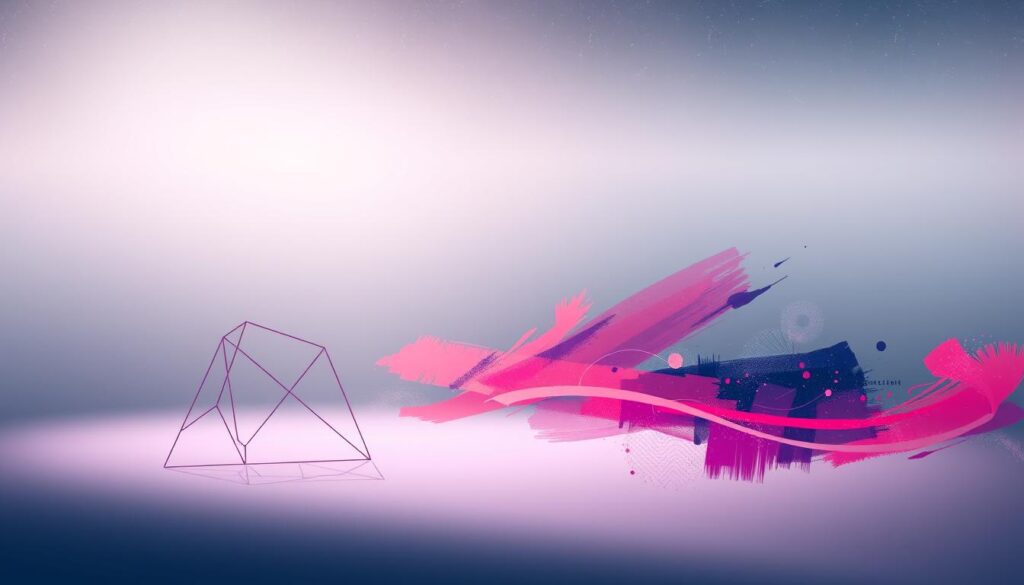
Fractals: Nature’s Mathematics in Digital Form
Fractals represent a fascinating intersection of geometry and art, offering endless possibilities for digital creators. These mathematical constructs have the unique ability to model the complexity of natural phenomena, from the branching of trees to the flow of rivers.
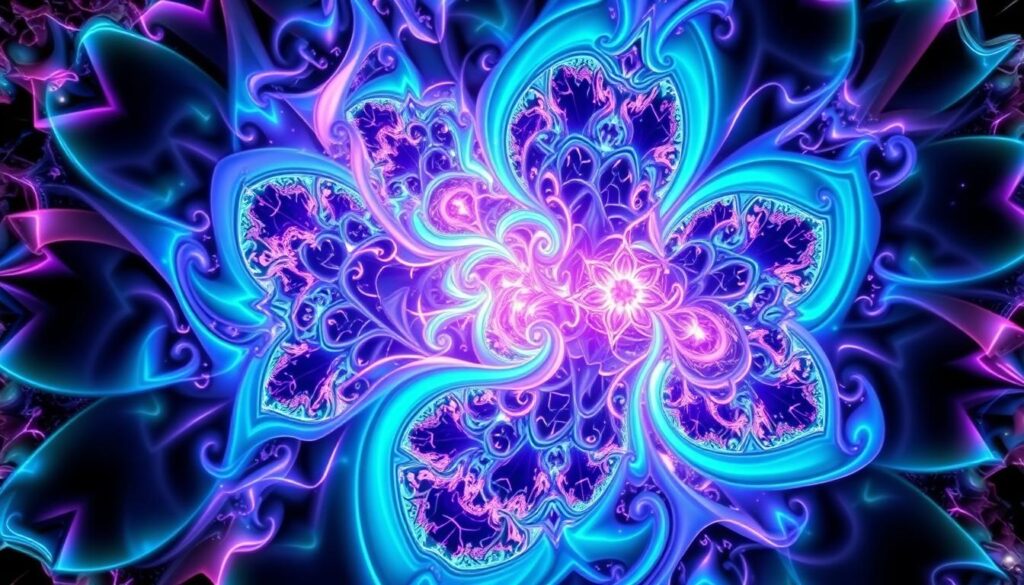
Understanding Fractal Geometry
Fractal geometry is based on the principle of self-similarity, where a pattern is repeated at different scales. This repetition creates the intricate and detailed structures that are characteristic of fractals. Fractal geometry allows artists to generate complex landscapes and patterns that would be difficult to achieve by hand.
The Mandelbrot Set and Digital Landscapes
The Mandelbrot Set is one of the most iconic fractals, known for its boundary that encloses an infinite complexity. Digital artists often use the Mandelbrot Set as a starting point for creating surreal landscapes and intricate designs. By zooming into different parts of the set, artists can discover new patterns and shapes that inspire their work.
Creating Infinite Complexity from Simple Rules
One of the most remarkable aspects of fractals is their ability to generate infinite complexity from simple mathematical rules. This property makes fractals a powerful tool in digital art, enabling artists to create detailed, high-resolution images from straightforward algorithms.
Practical Applications in Texture Generation
Fractals are widely used in texture generation for digital art and animation. By applying fractal algorithms, artists can create realistic textures that mimic the complexity of natural surfaces, such as stone, water, and foliage.
Fractal Art Techniques for Beginners
For those new to fractal art, starting with simple software tools that allow the exploration of fractal geometry can be beneficial. Experimenting with different fractal formulas and coloring techniques can help beginners understand how to harness the creative potential of fractals in their digital art.
Algorithms as Artistic Tools
Algorithms have become indispensable tools for digital artists, offering unprecedented creative possibilities. By leveraging mathematical principles, artists can now generate complex, varied, and often randomized elements with ease.
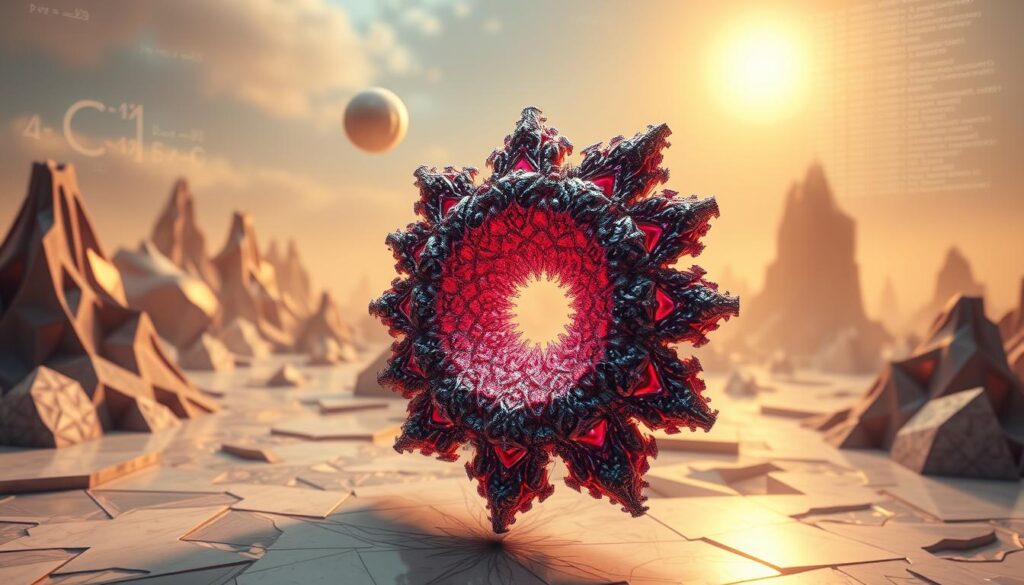
Procedural Generation Techniques
Procedural generation techniques allow artists to create intricate designs and patterns using algorithms. This approach enables the production of unique content that can be tailored to specific artistic visions.
Random Number Generators in Art
Random number generators introduce an element of unpredictability, allowing artists to explore new and unexpected creative territories. This technique is particularly useful in generating natural-looking textures and patterns.
Deterministic Algorithms for Reproducible Results
In contrast, deterministic algorithms provide a means to achieve reproducible results, ensuring that the artistic output remains consistent across different iterations. This is crucial for artists who need to refine their work iteratively.
When Code Becomes Creative Expression
As artists become more adept at using algorithms, code itself becomes a form of creative expression. The boundaries between art and mathematics blur, giving rise to innovative digital art forms that were previously unimaginable.
- Artists can now create dynamic, interactive installations that respond to viewer inputs.
- The use of algorithms enables the generation of complex fractals and geometric patterns.
- Mathematical models can be used to simulate real-world phenomena, adding realism to digital art.
By embracing algorithms as artistic tools, digital artists are pushing the frontiers of creativity, marrying the precision of math with the imagination of art.
What No One Tells You About the Link Between Math and Digital Art
The connection between mathematics and digital art is often misunderstood, with many believing that creativity and logic are mutually exclusive. However, the reality is that mathematical concepts are fundamental to creating digital art, and understanding these principles can enhance an artist’s creative vision.
The Misconception of Creativity vs. Logic
Many artists view mathematics as a dry, logical discipline that has little to do with creativity. However, this misconception overlooks the fact that math is not just about numbers and formulas; it’s also about patterns, structures, and relationships. These are the same elements that artists use to create visually appealing and meaningful compositions.
Key mathematical concepts such as geometry, fractals, and symmetry play a crucial role in digital art. For instance, fractals are used to create intricate patterns and landscapes that would be impossible to achieve by hand.
- Fractals provide a way to model natural phenomena, such as clouds, mountains, and trees.
- Geometric transformations enable artists to create complex shapes and patterns.
- Symmetry is used to create a sense of balance and harmony in compositions.
How Mathematical Thinking Enhances Artistic Vision
Mathematical thinking can enhance an artist’s creative vision by providing new ways to approach problems and think about art. By understanding mathematical concepts, artists can gain a deeper appreciation for the underlying structures that govern the visual world.
Problem-Solving Approaches for Artists
Mathematics teaches artists how to break down complex problems into manageable parts, analyze them, and find creative solutions. This skill is invaluable in digital art, where artists often need to troubleshoot technical issues or find new ways to achieve a particular effect.
Finding Beauty in Mathematical Constraints
Working within mathematical constraints can actually inspire creativity, as artists are forced to think outside the box and find innovative solutions. For example, using algorithms to generate art can lead to unexpected and exciting results.

Geometric Patterns and Symmetry in Digital Design
The use of geometric patterns and symmetry in digital art has become a hallmark of modern design, offering a blend of aesthetics and mathematical precision. These elements are crucial in creating visually appealing and balanced compositions.
The Golden Ratio in Digital Compositions
The golden ratio, approximately equal to 1.618, is a mathematical constant believed to possess unique aesthetic properties. In digital compositions, the golden ratio is used to create harmonious proportions and balance. Designers apply this ratio to arrange elements, ensuring a natural flow and visual appeal.
Tessellations and Repeating Patterns
Tessellations are repeating patterns of shapes that fit together without overlapping. In digital art, tessellations are used to create intricate and detailed designs. These patterns can be simple or complex, depending on the shapes and rules used to generate them.
Symmetry as a Design Principle
Symmetry is a powerful design principle that creates a sense of order and stability. In digital art, symmetry can be achieved through various techniques, including reflection and rotation. It helps in creating a focal point and guiding the viewer’s attention.
Rotational and Reflective Symmetry Tools
Digital design tools often include features for creating rotational and reflective symmetry. These tools allow designers to easily create symmetrical compositions by mirroring or rotating elements around a central point.
Breaking Symmetry for Visual Interest
While symmetry can create a sense of harmony, breaking symmetry can add visual interest and dynamism to a composition. Designers often intentionally disrupt symmetry to create tension or highlight specific elements.
Color Theory: The Mathematical Approach
Color theory, when viewed through a mathematical lens, reveals new dimensions in digital artistry. The precise application of mathematical principles allows digital artists to create harmonious and visually appealing compositions.
The foundation of digital color is the RGB color model, which combines red, green, and blue light in various intensities to produce a wide spectrum of colors. Understanding the mathematical underpinnings of this model is crucial for digital artists.
RGB Color Models and Digital Palettes
The RGB color model is based on the additive mixing of red, green, and blue light. Each color is represented by a set of three values, typically ranging from 0 to 255, indicating the intensity of each primary color. This system allows for the creation of over 16 million different colors.
Algorithms for Color Harmony and Contrast
Algorithms play a significant role in achieving color harmony and contrast in digital art. By applying mathematical formulas, artists can generate color schemes that are aesthetically pleasing and balanced.
Using Mathematical Formulas for Color Selection
Mathematical formulas can be used to select colors that complement each other. For instance, the principle of complementary colors can be applied using simple arithmetic operations on color values.
Programmatic Color Schemes
Programmatic color schemes involve using algorithms to generate colors based on specific rules or patterns. This approach enables artists to explore a vast range of color possibilities systematically.
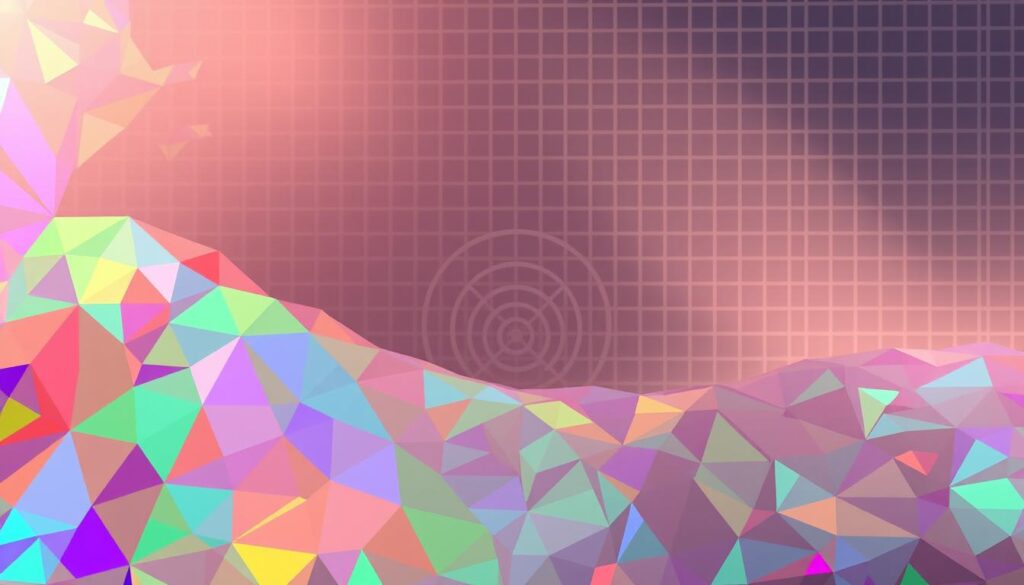
| Color Model | Description | Mathematical Basis |
|---|---|---|
| RGB | Additive color model used in digital displays | Combination of red, green, and blue light intensities |
| CMYK | Subtractive color model used in printing | Combination of cyan, magenta, yellow, and black inks |
| HSV | Color model based on hue, saturation, and value | Transformation of RGB values into cylindrical coordinates |
By embracing the mathematical aspects of color theory, digital artists can enhance their creative work and achieve new levels of sophistication in their art.
3D Modeling: Where Math Shapes Virtual Worlds
In the realm of 3D modeling, mathematics is not just a tool, but the very language that shapes the digital landscape. The creation of virtual worlds, whether for entertainment, simulation, or visualization, relies heavily on mathematical concepts.
Polygons, Vertices, and the Building Blocks of 3D Art
The foundation of 3D modeling lies in its basic building blocks: polygons and vertices. These geometric elements are manipulated using various mathematical algorithms to create complex shapes and structures. Understanding the mathematical properties of these elements is crucial for creating realistic models.
Mathematical Transformations in Animation
Mathematical transformations play a pivotal role in animating 3D models. Techniques such as rotation, scaling, and translation are all based on mathematical operations. These transformations enable the creation of smooth and realistic animations.
Matrix Operations for 3D Artists
Matrix operations are a fundamental tool in 3D modeling and animation. They allow artists to perform complex transformations on objects, such as rotating a character or scaling a landscape. Understanding how to use matrices effectively is essential for achieving the desired visual effects.
Physics Simulations in Digital Art
Physics simulations add another layer of realism to 3D models by simulating real-world physics. This involves complex mathematical calculations to model the behavior of objects under various forces. The result is more realistic and engaging digital art.
| Mathematical Concept | Application in 3D Modeling | Impact on Digital Art |
|---|---|---|
| Geometric Transformations | Manipulation of 3D objects | Enhanced realism and flexibility |
| Matrix Operations | Complex object transformations | Improved animation quality |
| Physics Simulations | Realistic object behavior | Increased immersion |
AI and Generative Art: The New Frontier
The intersection of AI and generative art is revolutionizing the digital art landscape. By leveraging complex algorithms and neural networks, artists can now create art that is not only visually stunning but also mathematically precise.
Neural Networks as Artistic Collaborators
Neural networks are being increasingly used as collaborative tools by artists. These networks can generate art based on learned patterns, allowing artists to explore new creative possibilities.
Understanding GAN Architecture for Artists
Generative Adversarial Networks (GANs) are a type of neural network that consists of two parts: a generator that creates art and a discriminator that evaluates it. Understanding GAN architecture is crucial for artists looking to harness its creative potential.
Training Models with Artistic Intent
Training GANs requires a dataset that reflects the artist’s intent. By carefully curating the training data, artists can influence the output of the GAN, ensuring that it aligns with their artistic vision.
The Mathematics Behind Style Transfer and GANs
The mathematics underlying style transfer and GANs is rooted in linear algebra and calculus. Techniques such as style transfer allow artists to merge different styles, creating unique digital art pieces. GANs, on the other hand, use complex mathematical functions to generate art that is often indistinguishable from human-created work.
By embracing these mathematical principles, artists can unlock new levels of creativity in digital art, pushing the boundaries of what is possible.
Conclusion: The Endless Dialogue Between Numbers and Pixels
The intricate relationship between math and digital art reveals a fascinating world where creativity and logic converge. As explored throughout this article, the connection between math and art is not just a coincidence, but a fundamental aspect of digital artistry.
From the geometric patterns and symmetry in digital design to the algorithms that drive procedural generation techniques, math plays a vital role in shaping the digital art landscape. The use of fractals, 3D modeling, and AI-generated art further underscores the significance of mathematical concepts in creating visually stunning and complex digital artworks.
Understanding what no one tells you about the link between math and digital art can empower artists, designers, and creatives to tap into the full potential of digital media. By embracing the connection between math and art, individuals can unlock new avenues for creative expression and push the boundaries of what is possible in the digital realm.
